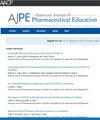The Role of Biomedical and Pharmaceutical Sciences in Pharmacy Education and Practice
IF 3.8
4区 教育学
Q1 EDUCATION, SCIENTIFIC DISCIPLINES
引用次数: 0
Abstract
A current major topic of conversation in academic pharmacy is “curricular hoarding,” the overloading of the curriculum due to the steady addition of required knowledge and skills without a concomitant subtraction of existing content. It can be tempting to consider addressing hoarding by just reducing content in the foundational biomedical and pharmaceutical sciences or by shifting some foundational content into prerequisites for admission into the Doctor of Pharmacy program. The health care education literature suggests that this approach would negatively impact the development of the critical and clinical thinking skills needed by a modern pharmacist. This commentary is intended to inform conversations on curricular hoarding by affirming and demonstrating the reliance of pharmacists’ clinical and critical thinking on the scientific concepts of the biomedical and pharmaceutical science disciplines and reiterating the importance to the practicing pharmacist of a deep understanding of these concepts, conferred through a careful and intentional educational integration.
生物医学和制药科学在药学教育和实践中的作用。
目前,药学学术界的一个主要话题是 "课程囤积",即由于不断增加所需的知识和技能,而没有同时减少现有的内容,导致课程负担过重。人们很容易考虑通过减少基础生物医学和制药科学的内容,或将一些基础内容转为药学博士课程的入学先修课程来解决囤积问题。医疗保健教育文献表明,这种方法会对现代药剂师所需的批判性思维和临床思维能力的培养产生负面影响。本评论旨在通过肯定和证明药剂师的临床和批判性思维依赖于生物医学和制药科学学科的科学概念,并重申通过精心和有意的教育整合而获得的对这些概念的深刻理解对执业药剂师的重要性,从而为有关课程囤积的对话提供信息。
本文章由计算机程序翻译,如有差异,请以英文原文为准。
求助全文
约1分钟内获得全文
求助全文
来源期刊
CiteScore
4.30
自引率
15.20%
发文量
114
期刊介绍:
The Journal accepts unsolicited manuscripts that have not been published and are not under consideration for publication elsewhere. The Journal only considers material related to pharmaceutical education for publication. Authors must prepare manuscripts to conform to the Journal style (Author Instructions). All manuscripts are subject to peer review and approval by the editor prior to acceptance for publication. Reviewers are assigned by the editor with the advice of the editorial board as needed. Manuscripts are submitted and processed online (Submit a Manuscript) using Editorial Manager, an online manuscript tracking system that facilitates communication between the editorial office, editor, associate editors, reviewers, and authors.
After a manuscript is accepted, it is scheduled for publication in an upcoming issue of the Journal. All manuscripts are formatted and copyedited, and returned to the author for review and approval of the changes. Approximately 2 weeks prior to publication, the author receives an electronic proof of the article for final review and approval. Authors are not assessed page charges for publication.

 求助内容:
求助内容: 应助结果提醒方式:
应助结果提醒方式:


